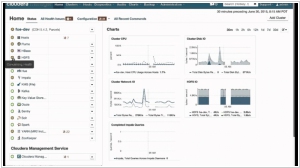Cloudera vs Teradata
March 09, 2025 | Author: Michael Stromann
12★
Cloudera helps you become information-driven by leveraging the best of the open source community with the enterprise capabilities you need to succeed with Apache Hadoop in your organization. Designed specifically for mission-critical environments, Cloudera Enterprise includes CDH, the world’s most popular open source Hadoop-based platform, as well as advanced system management and data management tools plus dedicated support and community advocacy from our world-class team of Hadoop developers and experts. Cloudera is your partner on the path to big data.
11★
Teradata Aster features Teradata Aster SQL-GR analytic engine which is a native graph processing engine for Graph Analysis across big data sets. Using this next generation analytic engine, organizations can easily solve complex business problems such as social network/influencer analysis, fraud detection, supply chain management, network analysis and threat detection, and money laundering.
See also:
Top 10 Big Data platforms
Top 10 Big Data platforms
Cloudera and Teradata are both rather good at handling absurdly large amounts of data, the kind that would make a mere human's brain melt like an ice cube on Venus. They both promise to help companies make sense of the chaotic, swirling mass of information they generate daily, offering cloud options, analytics tools and integration with all sorts of flashy dashboards. In short, they exist to prevent executives from staring blankly at spreadsheets and instead let machines do the staring for them.
Cloudera, born in 2008 in the grand tradition of Silicon Valley startups, is deeply in love with all things open-source. It takes Hadoop, Spark and other delightfully complex technologies and welds them together into something that enterprises can pretend they understand. It thrives in hybrid and multi-cloud environments, making it perfect for companies that like their data scattered across multiple locations for no apparent reason. It also leans heavily into AI and machine learning, because no self-respecting modern tech company would dare omit those words from their marketing.
Teradata, on the other hand, has been around since 1979, which in tech years makes it positively ancient—think of it as the wise old sage of data warehousing. It was built for structured data, neatly arranged in rows and columns, like a well-behaved schoolchild. Unlike Cloudera’s open-source enthusiasm, Teradata prefers a proprietary approach with its Massively Parallel Processing architecture, which sounds terribly impressive and is, indeed, terribly expensive. It excels at helping enormous corporations crunch transactional data with the sort of efficiency that would make an accountant weep with joy.
See also: Top 10 Big Data platforms
Cloudera, born in 2008 in the grand tradition of Silicon Valley startups, is deeply in love with all things open-source. It takes Hadoop, Spark and other delightfully complex technologies and welds them together into something that enterprises can pretend they understand. It thrives in hybrid and multi-cloud environments, making it perfect for companies that like their data scattered across multiple locations for no apparent reason. It also leans heavily into AI and machine learning, because no self-respecting modern tech company would dare omit those words from their marketing.
Teradata, on the other hand, has been around since 1979, which in tech years makes it positively ancient—think of it as the wise old sage of data warehousing. It was built for structured data, neatly arranged in rows and columns, like a well-behaved schoolchild. Unlike Cloudera’s open-source enthusiasm, Teradata prefers a proprietary approach with its Massively Parallel Processing architecture, which sounds terribly impressive and is, indeed, terribly expensive. It excels at helping enormous corporations crunch transactional data with the sort of efficiency that would make an accountant weep with joy.
See also: Top 10 Big Data platforms





